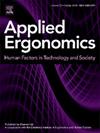Characterising the physical and physiological demands of essential tasks across the Australian Army
IF 3.4
2区 工程技术
Q2 ENGINEERING, INDUSTRIAL
引用次数: 0
Abstract
Understanding the physical task demands across Army can help to inform physical employment standards (PES) and physical conditioning programs. Job task analysis was performed for 55 Australian Army trades to determine criterion tasks. Of the 139 criterion tasks, 60% were categorised manual handling and 32% load carriage. Lift to Platform tasks were most prevalent (34%) with a median lift height and mass of 1.5 m and 25 kg, followed by lift and carry tasks (23%) with a 30 m carry and 26 kg mass. Physiological demands were moderate, with a median O2 and relative intensity of 1.91 L min−1 and ∼46% VO2max. Load carriage median external load, and O2 were 22 kg and 2.05 L min−1. Combat Arms trades had higher task demands compared to non-combat trades. These results emphasise the importance of manual handling and load carriage for Army personnel and provide the basis for PES development and targeted physical conditioning.
描述澳大利亚军队基本任务的生理和生理需求
了解整个陆军的物理任务需求可以帮助告知物理就业标准(PES)和物理调理计划。工作任务分析进行了55澳大利亚陆军贸易,以确定标准任务。在139个标准任务中,60%被归类为手动处理,32%被归类为负载运输。升降机至平台任务最普遍(34%),升降机高度和质量中位数分别为1.5米和25公斤,其次是升降机和搬运任务(23%),搬运高度和质量中位数分别为30米和26公斤。生理需求适中,中位V˙O2和相对强度为1.91 L min - 1和~ 46% VO2max。载货车厢中位外载和V˙O2分别为22 kg和2.05 L min−1。战斗武器交易比非战斗交易有更高的任务要求。这些结果强调了陆军人员手动操作和负载运输的重要性,并为PES开发和有针对性的身体调理提供了基础。
本文章由计算机程序翻译,如有差异,请以英文原文为准。
求助全文
约1分钟内获得全文
求助全文
来源期刊

Applied Ergonomics
工程技术-工程:工业
CiteScore
7.50
自引率
9.40%
发文量
248
审稿时长
53 days
期刊介绍:
Applied Ergonomics is aimed at ergonomists and all those interested in applying ergonomics/human factors in the design, planning and management of technical and social systems at work or leisure. Readership is truly international with subscribers in over 50 countries. Professionals for whom Applied Ergonomics is of interest include: ergonomists, designers, industrial engineers, health and safety specialists, systems engineers, design engineers, organizational psychologists, occupational health specialists and human-computer interaction specialists.
 求助内容:
求助内容: 应助结果提醒方式:
应助结果提醒方式:


